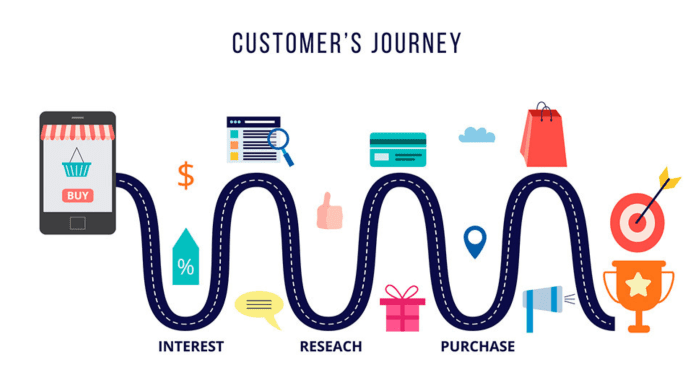Telling narratives has long been a fundamental aspect of human civilization. Storytelling has always captured our hearts and minds, from prehistoric cave paintings to the newest blockbuster films. In marketing, customer journeys that are both engaging and resonate with audiences are created by utilising the power of storytelling.
Before delving into the art of crafting customer journeys, it’s essential to understand why storytelling is so effective. Our brains are hardwired to respond to narratives. When we hear a story, our brains release oxytocin, often referred to as the “love hormone.” This chemical is associated with bonding, trust, and empathy, making it a potent tool for marketing.
Stories have a remarkable ability to tap into our emotions. When individuals engage with a compelling narrative, it triggers the release of oxytocin, a neurochemical associated with trust, bonding, and empathy. This emotional connection forms a profound link between customers and your brand. It goes beyond mere transactions and cultivates a sense of belonging and loyalty. Customers who feel emotionally connected are not just one-time buyers; they become repeat purchasers, brand advocates, and even storytellers themselves, sharing their positive experiences with others.
Stories are at their most influential when they include characters and scenarios that resonate with the audience. When customers can see themselves or their challenges reflected in your brand’s narrative, it forges a powerful bond. This connection is based on shared experiences, needs, or aspirations. As a result, customers are more likely to identify with your products or services, making them a natural choice when it comes to fulfilling their needs or desires.
The human brain is wired to retain information in a narrative format. Stories provide a structure and context that aids in information retention. When your brand’s message is delivered through a well-crafted narrative, it has a greater chance of being etched into the memory of your audience. This memory retention ensures that your brand remains top-of-mind when customers consider their options. In a competitive market, being memorable is a distinct advantage.
Traditional advertising often struggles to captivate audiences on a profound level. Stories, on the other hand, have an innate ability to engage the audience emotionally and intellectually. They draw customers into the narrative, inviting them to become active participants in the story. This involvement fosters a sense of investment in your brand’s journey. Customers who feel engaged are more likely to stay connected, exploring your products and services, and advocating for your brand within their own circles.
In sum, the impact of storytelling on customer journeys goes far beyond superficial marketing techniques. It leverages the core of human psychology, nurturing emotional connections, strengthening relatability, enhancing memory retention, and driving deeper engagement. By understanding and harnessing these elements, brands can create narratives that not only capture attention but also resonate with their audiences on a profound and enduring level. This, in turn, transforms casual customers into loyal supporters and brand champions.
The Elements of Effective Storytelling
Firstly, Introduce relatable characters, whether they are customers who have benefited from your product or employees who embody your brand’s values. Develop these characters throughout the customer journey. Every good story has a conflict that is eventually resolved. Showcase how your product or service can solve a problem or fulfill a need. This creates a sense of satisfaction and closure for the customer.
Further, authenticity is paramount. Customers can sense when a story is disingenuous. Share real experiences and customer testimonials to build trust. Use visuals, such as images and videos, to enhance the storytelling experience. Visual elements make the narrative more compelling and memorable.
Crafting the Customer Journey
- Audience Understanding:
At the core of every compelling story is a deep understanding of your audience. This understanding is not merely a superficial appreciation but a result of thorough market research. By delving into the needs, desires, and pain points of your target demographic, you gain valuable insights. These insights serve as the foundation upon which your narrative is built. Tailoring your story to directly address these concerns allows you to establish a genuine connection with your audience.
- Defining the Customer Journey:
The customer journey is a multi-stage process that individuals go through when interacting with your brand. It spans from the initial awareness of your products or services to the eventual purchase and, importantly, extends beyond that point. To maximize the impact of your storytelling, it’s imperative to outline and understand these stages. At each juncture, you should seamlessly incorporate a part of your brand’s narrative into the customer’s experience. This alignment ensures that your story guides customers at every step, facilitating a consistent and engaging journey.
- Consistency as a Pillar:
The integrity of your brand’s narrative relies heavily on consistency. To establish trust and reinforce the story, it’s vital that the narrative remains unwavering across all touchpoints. This includes your website, social media channels, advertising campaigns, and customer support interactions. Consistency ensures that customers receive a coherent and reliable message, solidifying their understanding of your brand and its values.
- Personalization for Relevance:
Generic, one-size-fits-all approaches are no longer sufficient in the modern marketing landscape. Personalization is key. By segmenting your audience and crafting content and messages tailored to each group, you demonstrate an acute awareness of their unique needs. This tailored approach not only resonates with your audience but also showcases your commitment to addressing their individual preferences, resulting in a more meaningful connection.
- Crafting the Call to Action (CTA):
The climax of your brand’s narrative lies in the call to action (CTA). This is the pivotal moment when you guide customers along their journey, encouraging them to take specific actions that align with your brand’s objectives. Whether it’s enticing them to sign up for a newsletter, try a free trial, or make a purchase, the CTA is an integral part of the storytelling process. It propels customers from passive observers to active participants in your brand’s narrative.
- Embracing the Feedback Loop:
Effective storytelling is a dynamic and evolving process. Encouraging customer feedback and reviews allows your audience to become part of your brand’s story. Positive feedback becomes a testimonial within the narrative, reinforcing the positive aspects of your brand. Constructive criticism, on the other hand, serves as a catalyst for story improvement. It demonstrates your receptiveness to customer concerns and your commitment to continually enhance their experience.
The science of storytelling is a potent tool for crafting customer journeys that resonate and drive brand success. By understanding the psychology of storytelling, incorporating key elements of effective narratives, and tailoring your stories to your audience, you can create customer journeys that engage, emotionally connect, and leave a lasting impression. In the world of marketing, it’s not just about the product or service you offer; it’s about the compelling story you tell that makes your brand unforgettable.





